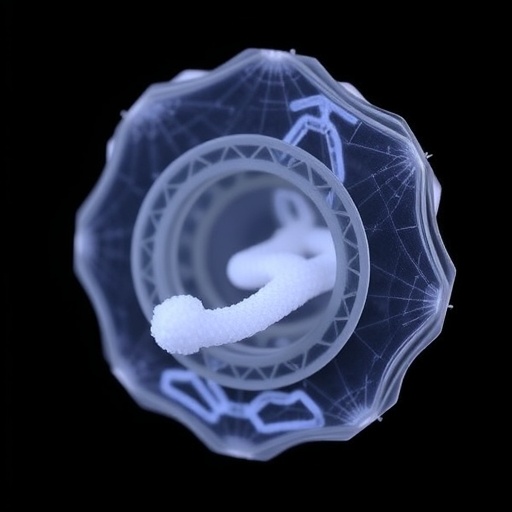After undergoing vocal cord surgery, numerous patients often confront the challenge of stiff vocal folds that hinder their speech capabilities. In an innovative turn of events, researchers have harnessed the power of hydrogels—biocompatible materials known to enhance healing. However, the precise delivery of these hydrogels to the delicate vocal cord area presents a significant hurdle. A groundbreaking solution has emerged from a collaborative effort between biomechanical engineers and surgeons, resulting in the creation of a 3D-printing soft robot. This device is specifically engineered to deliver hydrogels directly to the surgical site, aiming to reconstruct tissues altered or removed during the surgical procedure. What’s remarkable is that the printhead of this robot measures a mere 2.7 mm in dimensions, marking it as the smallest bioprinter ever reported.
The principal investigator, Swen Groen, a biomedical engineer from McGill University, highlighted that the device was meticulously designed with an emphasis on both precision and ease of use for surgeons. Its compact and flexible design allows for seamless integration into existing surgical workflows while offering real-time manual control, which is crucial in such a limited work environment typically found during vocal cord surgeries. This precision is paramount; not only does it enhance the accuracy of the hydrogel application, but it also allows surgeons to maintain clarity in viewing the vocal folds.
Voice disorders, which affect between 3% and 9% of individuals throughout their lives, often stem from the presence of cysts, growths, or cancers on the vocal cords. Surgical removal of these growths is common, but a frequent consequence is the development of fibrosis—a condition that leads to the stiffening of vocal cords and difficulties speaking. To combat this, surgeons generally resort to injecting hydrogels into the surrounding throat tissues. However, the complexity of accurately delivering these hydrogels via traditional injection methods has presented persistent challenges, which the new bioprinting technology aims to overcome.
To enhance hydrogel delivery, the research team embarked on the ambitious task of designing a miniature 3D printer suitable for use during vocal cord surgeries. Previous attempts at creating bioprinting devices have largely targeted applications in larger organs like the colon and liver, with many of these options being too cumbersome for the intricate environment of vocal cord procedures. Acceptance of a suitable printhead size that could navigate the oral cavity and be manipulated without obstructing the surgeon’s line of sight was an intense focus during the design stage.
The innovative design mimics the functionality of an elephant’s trunk. The robot’s printhead features a nozzle at the end of a flexible structure, which is controlled by tendon-like cables connecting to a control module. This module can be mounted on standard surgical microscopes, allowing for precision control during the operation. As the device operates, it precisely delivers a hyaluronic acid-based hydrogel in fine lines measuring 1.2 mm, enabling a controlled and targeted application that resembles the natural architecture of the vocal folds.
In testing phases, researchers showcased the bioprinter’s capabilities by manually controlling it to “draw” shapes such as spirals, hearts, and letters on flat surfaces, demonstrating its high degree of accuracy. Furthermore, the bioprinter was employed in delivering hydrogels to simulacra of vocal folds used for surgical training. Remarkably, the device successfully reconstructed complex vocal fold geometries, addressing specific tissue defects like those caused by lesion removals or complete vocal fold reconstructions.
One compelling aspect of this development is the reliable predictability of the device’s movements, even given its flexibility—a fact noted by coauthor Audrey Sedal. Sedal drew a comparison between the bioprinter and a typical garden hose, highlighting that unlike the erratic behavior seen in many tubes under pressure, this device maintains a consistent and controlled flow.
While the current version of the device is controlled manually, advances are underway to develop a hybrid system that blends both autonomous and manual functionalities. By refining the precision and reliability of the bioprinter, the research team aims to facilitate a more clinical application of this technology.
The next critical milestone for this project involves transitioning from laboratory settings to animal testing, a critical step that aims to gather evidence on the bioprinter’s efficacy and safety. Successful outcomes in preclinical trials would pave the way for human clinical trials, where the ultimate objective is to assess the device’s usability, accuracy in hydrogel application, and the resultant clinical outcomes relative to current treatment methodologies.
Research development of this nature embodies a transformative step forward in surgical practices concerning vocal health and rehabilitation. By leveraging innovative technologies such as 3D printing combined with advanced biomaterials, medical professionals are better equipped to address the complexities associated with post-surgical complications, ultimately enhancing patient recovery experiences and speech functionalities.
In summary, the intersection of engineering and medicine evidenced through this research heralds a promising future for patients facing the challenges of voice disorders. As these technologies evolve and clinical trials loom on the horizon, hopes are high for a new era of interventions that could
Tags: 3D printing technology in medicinebiomedical engineering breakthroughsbioprinting for tissue reconstructioncompact surgical devices for precision medicinehydrogels in vocal cord surgeryinnovative surgical tools for ENTMcGill University biomedical researchminimally invasive surgical techniquesprecision delivery systems in surgerysoft robotics in healthcaretissue engineering advancementsvocal cord rehabilitation technology





